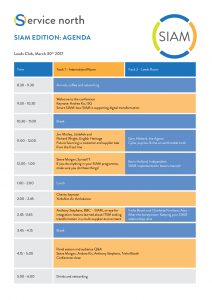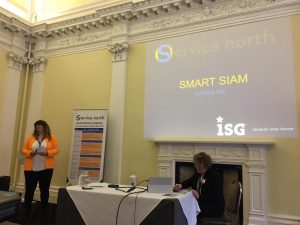Thank you to Caspar Miller from Westergaard for sharing his view on Service North: SIAM Edition. Over to you, Caspar!
Most conferences usually have more than one track, and I always find myself debating which speakers to choose. All the sessions seem so exciting, and they often also provide an opportunity to have a chat with some of the big shots. The SIAM conference in Leeds in March was no exception.
Session Presenter Steve Morgan: If you do anything in your SIAM programme, make sure you do these things!
Those who know a little about SIAM and may even have read a few of the white papers published in the past few years will probably recognise some of the names on the agenda. I found it especially difficult to choose between Steve Morgan and Kevin Holland, who have both written several white papers on SIAM and also contributed to writing the Service Integration and Management Foundation Body of Knowledge (download your free copy here). I have, however, had the pleasure of earlier sessions with Kevin Holland, and I even managed to talk to Kevin in one of the breaks, so I chose the very relevant topic presented by Steve Morgan.
Steve’s presentation concentrated on the ‘Crown Jewels’, the most important areas to keep under control, and then tune the rest of the setup like a graphic equaliser – tweaking every process between the retained organisation and your outsourcing partners. Listening to Steve talk about his experiences was truly inspirational.
Steve gave a humorous yet thought-provoking example of managing suppliers: a customer introduces a setup where, if a service provider failed to reach a target, the penalty was £1, which was to be delivered in person to the director’s office by the CEO of that supplier!
Session Presenter Andrea Kis: We sleepwalked into the 21st century with our 20th century mindset
The keynote speaker was Andrea Kis from ISG, a supplier on the bleeding edge of developing SIAM as a concept. Andrea’s presentation was very well designed with few slides, not too much text and many beautiful background images – a pleasant addition to the speech rather than your usual black-text, white-background over-texted slides. The main message was to forget ‘the box’ – ‘them’ (the business) and ‘us’ (the IT department).
Andrea also gave an example from real life: a maintenance window on an oil rig in the Gulf of Mexico was missed due to a 2.5 hour IT issue, and more than $50m was wasted. The answer from the service provider: Our service level target has not been breached. (Just take a moment to let that one sink in!)
Session Presenters Jon Morley and Richard Wright: The future of sourcing in a historic perspective
Among the others speakers were a shared session with a customer and a supplier, namely Historic England, caretakers of historic properties in the UK, and the supplier Littlefish. They emphasised that the customer doesn’t care whether it’s one or the other supplier, only whether it’s working. They also compared service integration to a conductor orchestrating an ensemble in a concert (a view I would personally challenge, however, in that integration of services rarely enjoys the privilege of knowing what the other musicians (suppliers) are doing, why and when.)
I took home two messages from that session: communication is paramount, so appoint a service ambassador – and if you use MVP (minimum viable product), then viable is more important than minimum!
A successful first conference on SIAM
All things considered a very inspiring and educational day, the conference was perhaps a little heavily represented by suppliers. Therefore, my last session for the day was a refreshing change in viewpoint, this time by none less than the BBC. Tony Stephens used a chicken-and-egg metaphor on technology versus business adaptation: are the needs of the business driving technology, or will the business simply have to live with what we provide them? The key is to get it right the first time and avoid a ‘ready-fire-aim’ culture.

“CIO, how does your current team support the goals and vision of the company?
– We don’t know, they didn’t come to us.” Andrea Kis


